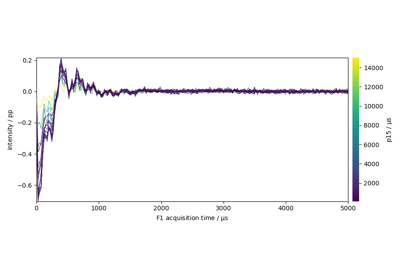spectrochempy.fft¶
- fft(dataset, size=None, sizeff=None, inv=False, ppm=True, **kwargs)[source]¶
Apply a complex fast fourier transform.
For multidimensional NDDataset, the apodization is by default performed on the last dimension.
The data in the last dimension MUST be in time-domain (or without dimension) or an error is raised.
To make reverse Fourier transform, i.e., from frequency to time domain, use the
iffttransform (or equivalently, theinv=Trueparameters.- Parameters
dataset (
NDDataset) – The dataset on which to apply the fft transformation.size (int, optional) – Size of the transformed dataset dimension - a shorter parameter is
si. by default, the size is the closest power of two greater than the data size.sizeff (int, optional) – The number of effective data point to take into account for the transformation. By default it is equal to the data size, but may be smaller.
inv (bool, optional, default=False) – If True, an inverse Fourier transform is performed - size parameter is not taken into account.
ppm (bool, optional, default=True) – If True, and data are from NMR, then a ppm scale is calculated instead of frequency.
**kwargs – Optional keyword parameters (see Other Parameters).
- Returns
out – Transformed
NDDataset.- Other Parameters
dim (str or int, optional, default=’x’.) – Specify on which dimension to apply this method. If
dimis specified as an integer it is equivalent to the usualaxisnumpy parameter.inplace (bool, optional, default=False.) – True if we make the transform inplace. If False, the function return a new object
tdeff (int, optional) – Alias of sizeff (specific to NMR). If both sizeff and tdeff are passed, sizeff has the priority.
See also
ifftInverse Fourier transform.
